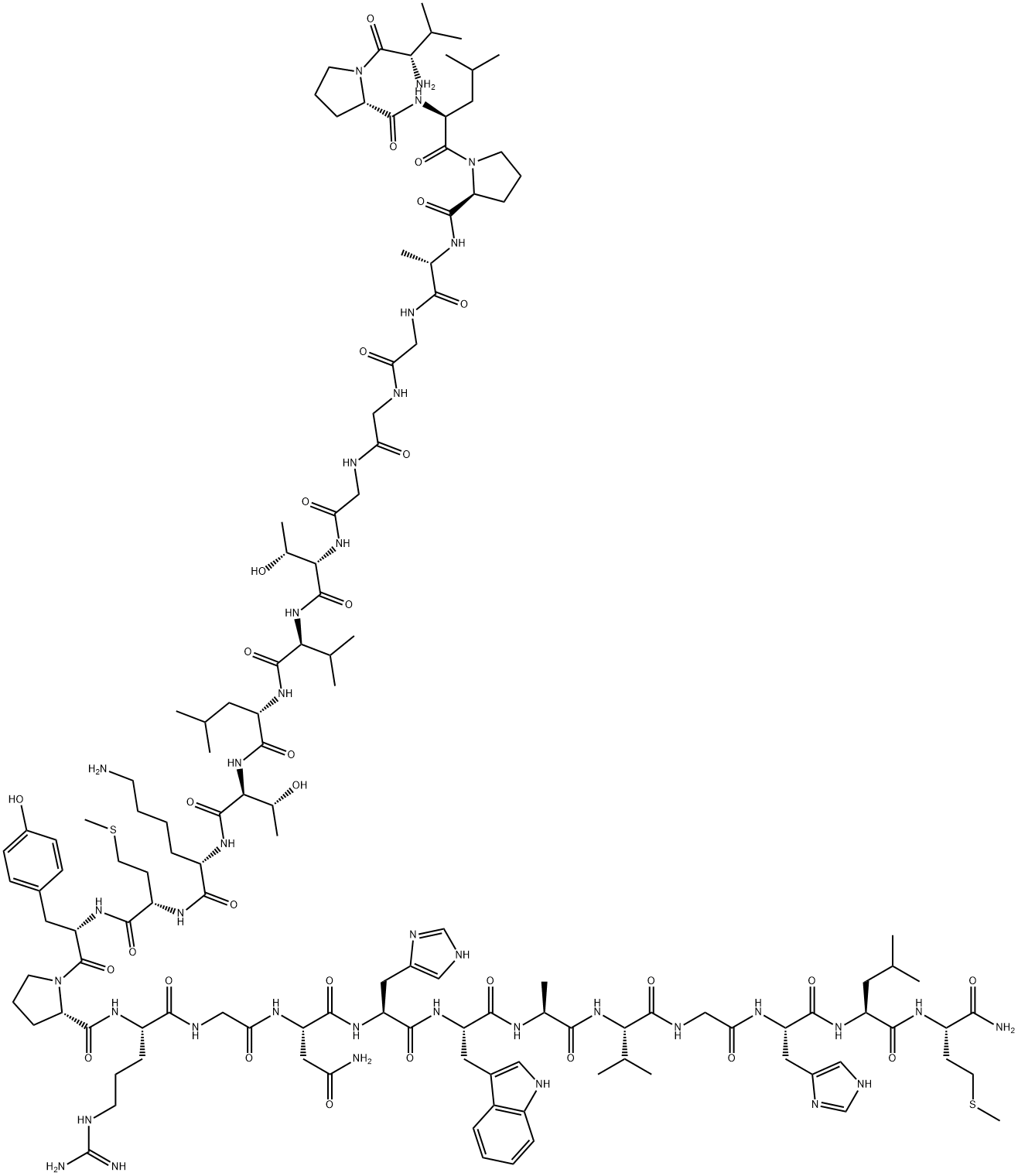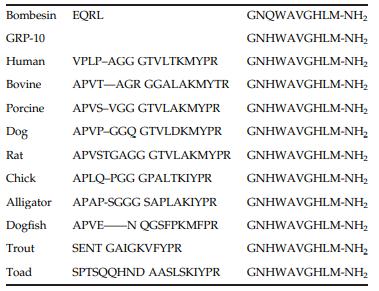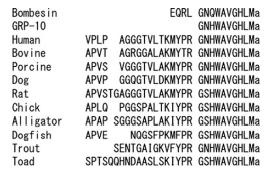
GASTRIN RELEASING PEPTIDE, HUMAN
- Product NameGASTRIN RELEASING PEPTIDE, HUMAN
- CAS93755-85-2
- CBNumberCB6271275
- MFC130H204N38O31S2
- MW2859.38
- MDL NumberMFCD00133362
- MOL File93755-85-2.mol
Chemical Properties
| Density | 1.46±0.1 g/cm3(Predicted) |
| storage temp. | −20°C |
| form | Powder |
| color | White to off-white |
| Water Solubility | Soluble to 1 mg/ml in water |
| Sequence | H-Val-Pro-Leu-Pro-Ala-Gly-Gly-Gly-Thr-Val-Leu-Thr-Lys-Met-Tyr-Pro-Arg-Gly-Asn-His-Trp-Ala-Val-Gly-His-Leu-Met-NH2 |
| UNSPSC Code | 51111800 |
| NACRES | NA.32 |
GASTRIN RELEASING PEPTIDE, HUMAN Price
| Product number | Packaging | Price | Product description | Buy |
|---|---|---|---|---|
| Sigma-Aldrich G8022 | 0.1mg | $146 | Gastrin Releasing Peptide human ≥97% (HPLC) |
Buy |
| Sigma-Aldrich G8022 | 0.5mg | $477 | Gastrin Releasing Peptide human ≥97% (HPLC) |
Buy |
| Sigma-Aldrich G8022 | 1mg | $833 | Gastrin Releasing Peptide human ≥97% (HPLC) |
Buy |
| Tocris 1789 | 1 | $298 | GRP(human) |
Buy |
| ApexBio Technology B5171 | 5mg | $780 | GRP(human) |
Buy |
GASTRIN RELEASING PEPTIDE, HUMAN Chemical Properties,Usage,Production
Discovery
First isolated from the porcine stomach and named gastrin-releasing peptide (GRP),1 GRP was originally believed to be a mammalian counterpart of the amphibian peptide, bombesin. Its structure has been determined in many mammals, including pigs, rats, mice, guinea pigs, dogs, and humans. In addition, GRP18–27, a possible fragment of mature GRP, was later isolated from the porcine spinal cord and originally called neuromedin C,2 although a more appropriate name is either GRP-10 or GRP18–27. GRP orthologs have been identified in birds, reptiles, amphibians, and teleost fish. On the other hand, it is reported that frogs have both GRP and bombesin, which are genetically distinct peptides, suggesting that GRP is not mammalian bombesin.
Structure
The human GRP precursor consists of 148 aa residues (rat, 147 aa). A predicted preproGRP translation product consists of a signal peptide, GRP1–27, and a C-terminal extended peptide termed proGRP31–125. Most GRP peptides have a common sequence motif, GXHWAVGHLM amide (X=N or S), at their C-terminus. Although the N-terminal sequences are less conserved across vertebrate species, many identified GRP peptides in mammals consist of 27 aa residues, excluding rats and mice (29 aa). In nonmammals, the amphibian GRP peptide consists of 29 aa residues, the reptile peptide of 28 aa residues, and the avian peptide of 27 aa residues while the teleost peptide appears to be shorter (24–25 aa residues).
Gene, mRNA, and precursor
The human GRP gene is located on chromosome 18 (18q21.32), and consists of three exons (mRNA, 850 bp long ) . Its mRNA produces a 125-aa preproGRP precursor protein. In chickens, the grp gene is located on chromosome Z. In Xenopus, the grp gene is predicted to be located on chromosome 1. In zebrafish, the grp gene is predicted to be located on chromosome 21 (CH211-233A1). GRP mRNA is produced in the CNS, stomach, intestine, pancreas, and lung in humans as well as other mammals. The expression of GRP mRNA is detected in the limbic system, including the amygdala as well as the hippocampus,8 and an overexpression in patients suffering from small cell lung cancer has been reported.Synthesis and release
In the CNS, bombesin or GRP immunoreactivity was detected in approximately 5% of dorsal root ganglion neurons and approximately 10% of trigeminal ganglion neurons. In the brain, abundant GRP immunoreactivity was observed in the cerebral cortex, hypothalamus, and medulla oblongata. In the gastrointestinal tract, abundant GRP-immunoreactive fibers were observed in the stomach, suggesting gastrin release, and the small intestine, colon, and pancreas. In addition, the overexpression of GRP has been demonstrated at both the mRNA and protein levels in various types of tumors, including lung, prostate, breast, stomach, pancreas, and colon.Receptors
GRPR is a GPCR superfamily with a seventransmembrane domain. GRPR is coupled to the Gq protein, and GRPR activation leads to an increase in intracellular Ca2+ and stimulation of the PLC/PKC and ERK/ MAPK pathways. In mammals, bombesin-like peptides act on a family of at least three GPCRs: the GRP-preferring receptor (GRPR), the neuromedin B-preferring receptor (NMBR), and the bombesin receptor subtype-3 (BRS-3), which is considered an orphan receptor at present. Human GRP binds GRPR (BB2 receptor) with a higher binding affinity (Ki of 1.8 - 0.4 nM) than that of NMBR (BB1 receptor) (Ki of 15 - 0.4 nM).Agonists and Antagonists
A fragment of the C-terminal of human GRP, GRP18–27 (GRP-10), is reported to be a selective and potent agonist for GRPR. The central administration of GRP-10 induces many physiological responses, similar to that with mature GRP. RC3095 has been reported as a selective and potent antagonist of GRPR. The central administration of RC-3095 attenuates many physiological responses.Biological functions
GRP functions via GRPR, which is highly expressed in the pancreas, and is also expressed in the stomach, adrenal cortex, and brain. Considerable evidence indicates that GRP plays a role in many physiological processes, including food intake, male sexual functions,circadian rhythms, sigh control, and fear-memory consolidation in the mammalian CNS. In addition, the itch sensation is a major biological function of GRP in mammals. In chicks, GRP functions as an anorexigenic factor in the brain.Clinical implications
GRP and GRPR often excessively express in endocrinerelated cancer cells such as small cell lung cancer, prostate cancer, and gastrointestinal tract cancer. ProGRP is known to be a specific tumor marker for the small cell lung cancer because the half-life of proGRP in the circulation is much longer than that of GRP. GRPR is also important in prostate cancer growth and progression in an androgen-dependent manner.Description
Gut-brain peptides are widely conserved in vertebrates, GRP is a neuropeptide that modulates the autonomic system. It is an anorexigenic factor in the brain, regulates male sexual function at the spinal cord level, conveys the itch sensation, and is also involved in many autonomic regulations in the brain. The expression of GRP is also a specific tumor marker for small cell lung cancer. It has the GXHWAVGHLM amide (X=N or S) sequence at its C-terminus.Uses
GRP (gastrin releasing peptide) has been used for absorption/neutralization of anti-GRP antibody prior to the tyramide signal amplification (TSA) procedure.General Description
GRP (gastrin releasing peptide) is the mammalian homolog of bombesin (BBS) and functions as a mitogen for multiple cancers, such as neuroblastoma. It is a ligand for GRPR (GRP receptor) and is expressed in a subtype of peptidergic dorsal root ganglion neurons.Biochem/physiol Actions
GRP (gastrin releasing peptide) functions as an autocrine growth factor for nueroblastoma. It facilitates cell survival in PI3K/AKT (phosphatidylinositol-3-kinase/ v-Akt murine thymoma viral oncogene)-mediated manner and cell proliferation and angiogenesis in neuroblastoma. This peptide is involved in the release of gastrin and the control of gastric acid secretion and motor function. In patients with atopic dermatitis, the serum levels of this peptide are linked with pruritus.Clinical Use
GRP mRNA is overexpressed in patients suffering from small cell lung cancer. Clinically, therefore, a higher level of circulating proGRP31–125 is a specific tumor marker for small cell lung cancer (higher than ~81.0 pg/mL in the plasma). In addition, intravenous infusions of GRP decrease spontaneous food intake in healthy men, suggesting GRP acts as a satiety signal in humans. GRP has not yet been used much clinically as a therapeutic agent.storage
Store at -20°CPreparation Products And Raw materials
GASTRIN RELEASING PEPTIDE, HUMAN Suppliers
Global(122)Suppliers
| Supplier | Tel | Country | ProdList | Advantage | |
|---|---|---|---|---|---|
| +86-755-89396905 +86-15013857715 |
admin@nexconn.com | China | 10311 | 58 | |
| 0551-65326643 18156095617 |
info@cellmano.com | China | 995 | 58 | |
| +86-0371-86658258 +8613203830695 |
factory@coreychem.com | China | 29810 | 58 | |
| +1-2135480471 +1-2135480471 |
sales@sarms4muscle.com | China | 10473 | 58 | |
| 0571-88211921 | sales1@gotopbio.com | CHINA | 2609 | 58 | |
| +1-708-310-1919 +1-13798911105 |
sales@invivochem.cn | United States | 6391 | 58 | |
| +8618108235634 | Cecilia@youngshechem.com | China | 2345 | 58 | |
| +86-13347807150 +86-13347807150 |
support@tgpeptide.com | China | 3279 | 58 | |
| +8617531972939 | anna@api-made.com | China | 2943 | 58 | |
| +8619375158599 | info@molchanges.com | China | 5223 | 58 |
GASTRIN RELEASING PEPTIDE, HUMAN Spectrum
93755-85-2, GASTRIN RELEASING PEPTIDE, HUMANRelated Search
PROMPT×
PROMPT
The What'sApp is temporarily not supported in mainland China
The What'sApp is temporarily not supported in mainland China
Cancel
Determine
